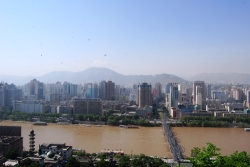
On the way to Dunhuang we stopped in Lanzhou, the capitol of Gansu province on a long layover. As we woke up on the train we looked out the windows and saw desert landscape that reminded both Aaron and I of southern and western Utah. The biggest difference besides a yellower soil was the extensive farms growing mostly cabbage and corn.
White Pagoda Hill

After arriving in Lanzhou we checked our bags at the train station and headed to White Pagoda Hill, what seemed to be the most interesting sight listed in Lonely Planet. It was easy to take a local bus to the bridge right across the river from the park. This river is China’s mother river, the Yellow River that stretches from Beijing to Qinghai province (in between Gansu and Tibet).

Across a small bridge is the park going up a hill and at the top is the relatively small White Pagoda. Unfortunately, we couldn’t get too close to the tower since there is construction all over the hill and around the pagoda. The construction is making nice paths and pavilions along the trails, but beware there are tons of stairs. There is a cable car that takes passengers from the opposite side of the river to the top of the hill.
The construction seems to be turning this area into a bigger destination for tourists with new old-style buildings that are or will be shops, restaurants and museums. Three of the museums are open although they didn’t appear completely finished since the audio-visual presentations were not working. The main purpose of these museums is to highlight the cultural heritage of the region.
Opera Museum

The first museum we visited is the Qin Opera Museum. This very nice museum succinctly and artfully takes visitors through different aspects of this performing art including the music, costumes and make-up, watching the show, the organization of troupes and more. Best of all it has English signs throughout explaining everything for all to understand and appreciate.
Intangible Heritage Museum

The museum just behind the opera museum highlights many pieces of Gansu’s “intangible” heritage. The displays show handicrafts like gourd carving and embroidery as well as cooking techniques and musical styles. It looked like there are spaces for performances and live displays integrated into the exhibits but like the A/V presentations were absent.
On the first floor of the museum there were also shops displaying paper-cutting and gourd carving and painting. The artists also have many pieces available for purchase. Some of the museum was not open yet so there should be more in the future.
Pottery Museum
The third museum we checked out is the Pottery Museum telling the story of the province’s clay-working heritage dating back thousands of years. The first level shows these ancient Chinese. The second floor displays examples of earthenware unearthed from all around the province and the various motifs for decorating. On the third floor was an area where people can make their own pottery, but this wasn’t available for us when we were there.

I think that once the construction and restoration is all done this park will be a very nice destination to learn about and soak up some Gansu culture and history. From there we wandered the city. We came across the Lanzhou Municipal Museum and explored a park and the pedestrian street.
The museum was small and showed us pretty much the same thing as the museums on the hill but there is a nice old pagoda in the courtyard of the museum with little Buddha statues in niches all around.
After wandering around in the sun, downing about five or six bottles of water each and Aaron getting new jeans for his recently ripped ones, we made our way back to the train station to wait for our ride to Dunhuang, which right before we should have begun boarding we found out was delayed for about an hour.






Chloe
i come from jiayuguan! a few hours from dunhuang and also in gansu. we seldom had visitors in gansu! welcome!